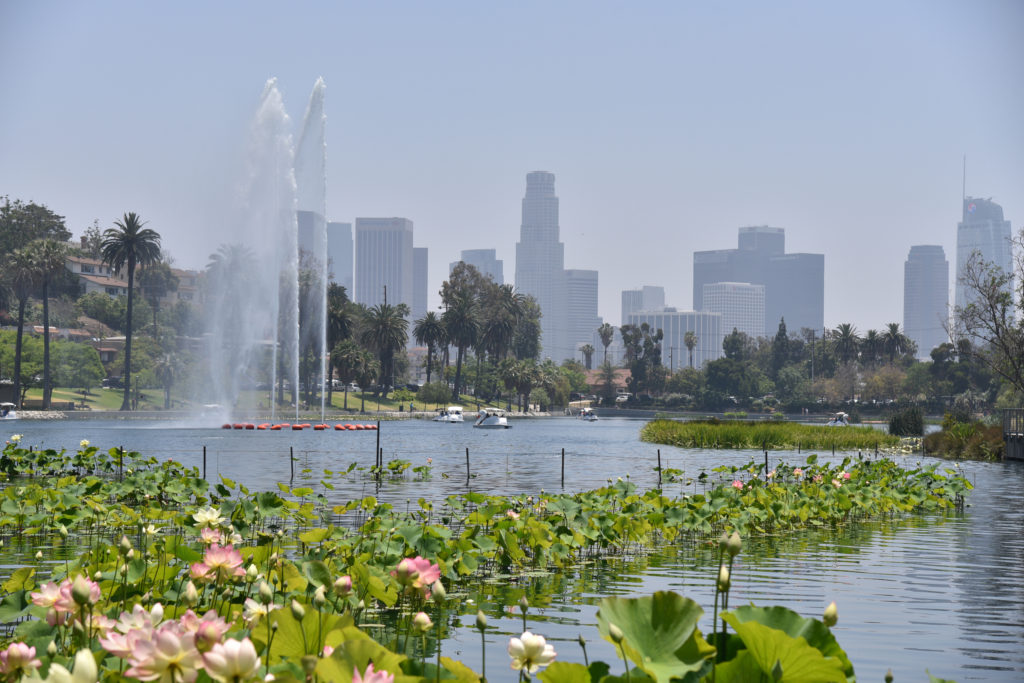Echo Park, the LA neighborhood hard by downtown, boasts the largest lotus stand in the western United States.
The lake where the lotuses live began as a man-made reservoir back in 1868. A surrounding park and boathouse were completed by 1895. By 1907, more green space had been added by extending the park south to Temple and north to Bellevue.
The lotuses bloom each summer, usually peaking in early July.
And they’re surrounded by mystery, intrigue, and crime.
For starters, nobody really knows where the original flowers came from. One legend, never proven, holds that Angelus Temple missionaries, followers of Aimee Semple McPherson, brought the seeds back from China.
An 1889 LA Times article mentions that a J.C. Harvey planned to donate some Egyptian lotuses from the Nile to area parks, but the Echo Park flowers are not Egyptian lotuses, nor are they water lilies.
Instead, says landscape architect and certified arborist Michael O’Brien, “Nelumbo nucifera is native to South Asia to Australia and is grown in tropical climates around the world. As to where these plants came from, the source is lost in the mists of time.”
Though the exact date is unknown, the lotuses by all accounts first appeared in the lake during the 1920s. At the time, water gardens had become au courant citywide. So had Egyptology, exotic locales, and a vague Eastern-philosophy aesthetic.
A 1929 LA Times photo caption reads, “Right now the beds of lotus lilies in Echo Park, Los Angeles, are coming into perfection. These are the sacred lilies of India, symbols of immortality, and to the Hindu mind the most perfect of all flowers.”
As for the intrigue, a 2013 LA Times piece by Marisa Gerber entitled “The salvation of Echo Park’s lotus bed is rooted in a bit of thievery” tells the story.
The annual Lotus Festival began in the 1970s. So popular was the lake and its annual display that the Echo Park neighborhood council adopted the lotus as its logo.
All went along nicely for many years. But in the early 2000s, the lotuses started dying — no one knew why. Predators? Pollution? By 2008, they were gone. Angelenos, heartbreakingly, still showed up for the festival.
Then, in 2007, the Los Angeles City Council approved a $45 million expenditure to drain the lake and restore the site to its former glory.
Meanwhile in 2005, an LA horticulturist named Randy McDonald attended the festival, illegally hacksawed and stole a single lotus shoot and, back at his Reseda nursery, obsessively tended it. News traveled through the underground plant grapevine and eventually made its way to landscape architect Josh Segal.
The upshot? The next year, McDonald ended up selling 376 lotus plants back to the city for 30 grand.
Only in LA.

Today, approaching the lake, you can find a nod to history in the form of an earth mother-lotus goddess mural by Ricardo Mendoza (2012) at the corner of Echo Park Avenue and Sunset Boulevard.
The lake is surrounded by shade trees and features marshy areas, shallows, and inlets. A fountain, installed as part of public improvements during the 1984 Olympics, thrillingly spouts three jets of water high into the sky.
Mallard ducks float regally across the mirrored surface. Canada geese nest. Clumps of water reeds sport spikes of purple flowers.
A child’s imagination could run wild here. Captain Hook might be lurking in a lagoon. Tinkerbell could be curled up on one of those cup-shaped green leaves. You could run away from your mean parents and live here with the lotuses alongside Thumbelina, the Little Mermaid, and the Water Babies.
A leisurely half-hour stroll around the perimeter is just the activity to soothe jangled urban nerves. My fellow walkers comprise a typical LA mix of fitness buffs, street photographers, tourists, dreamers, pre-gentrification locals, and unidentifiable riff-raff such as myself. Elderly couples slowly circle, homeless folks are spread out on the grass, a few hardy souls fish.
The lotuses themselves are exquisite, ranging in color from mother-of-pearl to creamy pale gold to lipstick pink. In some parts of the lake, the flowers reach their necks several feet above the water. In others, they waft charmingly on the surface.
It’s impossible to resist snapping photo after photo. But to capture the full delicacy, elegance, and subtle range of color you have to visit the lotuses in person.
The 39th Lotus Festival takes place on the weekend of July 13-14, noon to 9 p.m. Celebrating Asian Pacific cultures (in particular, this year, Thailand), the revelry kicks off with live music, a film screening, and cultural performances.
Among other offerings will be a food court, a silent auction, a children’s area, handcrafted artwork, origami workshops, and dragon boat races.
The Lord works in mysterious ways. “My specialty is reproduction,” says Randy McDonald, the lotus thief who, in a certain light, we have to thank for all this bounty.
“If you ever read the Bible, the fish and the bread growing like crazy, I’m that kind of guy when it comes to plants.”
Heather King is a blogger, speaker and the author of several books. For more, visit heather-king.com.
SPECIAL OFFER! 44 issues of Angelus for just $9.95! Get the finest in Catholic journalism with first-rate analysis of the events and trends shaping the Church and the world, plus practical advice from the world’s best spiritual writers on prayer and Catholic living, along with great features about Catholic life in Los Angeles. Subscribe now!

